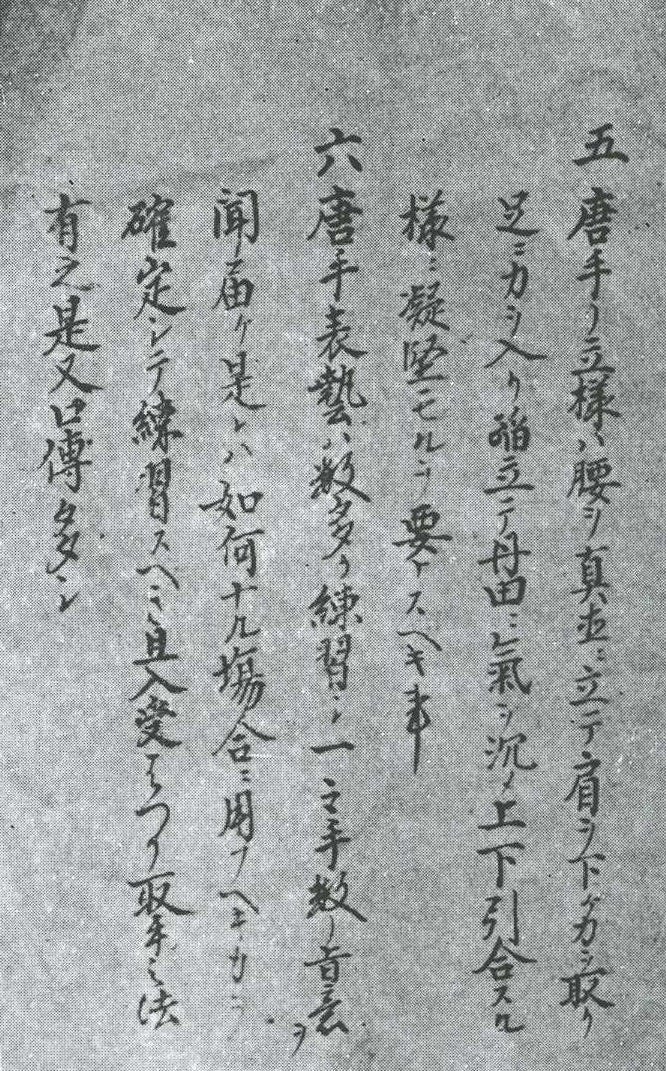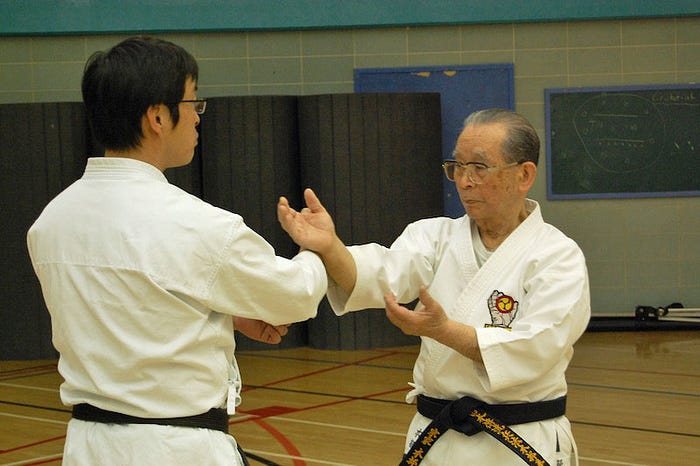The true techniques of karate were taught through kuden.

In the “Ten Articles of the Karate Mind,” or the so-called “Itosu Ten Precepts” (1908), written by Itosu Ankō in his later years, there is an interesting description of karate training methods in the Ryukyu Kingdom period.
6. The omote-gei (表芸, literally, the front art) of karate should be practiced in large numbers, asking the master about the meaning of each movement, and determining when this movement should be used. There are also the methods of iri (entering), uke-hazushi (receiving and removing), and torite. Many of these also have kuden (口伝, oral transmission).

The term “omote-gei of karate” is generally interpreted as referring to the kata (form). Considering the context, this understanding seems reasonable. The dictionary meaning of omote-gei (the front art) is “the art of being good at,” but here it probably means “basic training methods.” In other words, he taught that kata, the fundamentals of karate, should be practiced in large numbers. It is possible that the term “kata” did not exist at that time.
The next sentence, “asking the master about the meaning of each movement, and determining when this movement should be used,” probably refers to the modern term bunkai (analysis). In other words, Itosu Sensei taught that one should not just repeat kata but should think about the meaning of each movement, sometimes asking the master about it, and practicing with actual fighting in mind.
The word “when” probably means “in which situation in actual fighting.” This sentence indicates that Itosu Sensei did not regard kata as mere “gymnastics,” but that he did not deny its use as a “martial art” in actual fighting.
The next phrase, “entering, receiving and removing,” is one that is difficult to interpret. Previously, I had thought that this “entering” (iri) might refer to irimi (入身, entering the opponent’s body). However, as I mentioned before, Asato Ankō uses the word “enter” in the sense of “strike,” so I think it means “striking” here. Of course, in modern Japanese, we do not use the word “enter” in the sense of striking or thrusting.
The following “receiving and removing” (uke-hazushi) is a part that is subject to different interpretations. The details will be discussed later, but here I will interpret it in the sense of “the way of receiving (or blocking).”
Now, what is the meaning of kuden (oral transmission)? The Japanese-language dictionary “Daijirin” gives the following explanation.
(1) To transmit by word of mouth. Oral communication.
This is easily understood because it is a literal explanation. Hence, the above means that many of the techniques of striking, receiving, and torite are taught by the master explaining them directly to the student by mouth.
However, this is not the only meaning of kuden. It also has the following additional meaning.
(2) To transmit by word of mouth the secrets and esoteric knowledge of something.
Kuden also means the oral transmission of secrets and esoteric knowledge. In Japanese martial arts scrolls, after the names of techniques are listed, it is often written, “Each of the techniques listed on the right has an oral transmission.” This means that the name of the technique is written on the scroll, but the content of the technique is not written on the scroll so that it cannot be stolen, and the specific content is transmitted orally.

For example, a master might say to his student, “I have been teaching you this technique like this, but in fact, this is not the way to use it in a real battle. In fact, it is correct to use this technique in this way.” In other words, he would deny the technique he had previously taught his student, and then orally tell the student the true technique. In fact, Motobu Chōki and Uehara Seikichi also taught in this manner.
It may be difficult for modern martial arts practitioners to understand, but in the feudal era, martial arts techniques were a kind of “military secret,” so they took precautions to prevent them from being easily leaked outside the feudal domain.
Therefore, the meaning of the above “Itosu Ten Precepts” is as follows:
Kata should be practiced repeatedly. However, do not practice it in a careless manner. Always practice with the actual fight in mind, asking questions to the master about bunkai (analysis) and determining the meaning of the techniques as you practice. In addition, there are many secrets in the way of striking, receiving, and torite, so that the movements of kata cannot be used in a real fight without modification. Hence, the true techniques are to be transmitted orally from master to student according to the stage of training.
This is the antithesis of the claim that became mainstream in Okinawa in the 20th century that “everything in karate is in the kata” or that “if you only practice kata, you will naturally understand bunkai.”
It is true that basic karate techniques are included in kata. However, in many cases, these techniques cannot be used in actual fighting without modification. This is because the real techniques are camouflaged in the kata so that they cannot be stolen. Also, torite, or throwing and joint locking techniques, cannot be practiced alone. While it is possible to hone the techniques of striking and kicking to a certain extent in one-person training, this is not the case with torite. For example, there are individual differences in joint softness and pain tolerance. Even if the same technique is applied in the same way, it may or may not work depending on the person. Therefore, two-person training (kumite and torite) is essential, but these secrets cannot be taught to beginners. The real secret techniques were transmitted orally according to the stage of training in ancient times.
This idea, that true techniques are taught orally, seems to have been influenced by the Japanese martial arts through Satsuma. For example, in the kishōmon (application for initiation) of the Yakumaru Jiken-ryū of Satsuma, there is a sentence that reads, “The oral transmission must not be written down.” This is because the oral transmission is a secret and must not be inadvertently written down and leaked to the outside world.
Of course, the Chinese martial arts were also secretive, but considering that the word kuden (oral transmission) appears frequently in Japanese martial arts scrolls, it should be understood that there was a similar philosophy in Okinawa as in Japan.
By the way, is the above understanding of Article 6 of the “Itosu Ten Precepts” really correct? In particular, there is a possibility of a different or more in-depth interpretation of the phrase “iri, uke-hazushi.” In fact, the interpretation of this phrase is important for the study of karate history.
For example, uke-hazushi is interpreted by Kenjō Hiroshi as “the way of receiving and the way of removing the arm or collar when it is grabbed” (Kenjō Hiroshi, From Tōde to Karate, p. 50). In other words, he distinguishes between uke and hazushi, interpreting uke as the way of receiving, while hazushi is the way of removing the hand when an opponent grabs your arm (sleeve) or collar, as in judo or jūjutsu. He interprets it as a kind of jujutsu technique, or torite.
However, Motobu Choki also uses the term uke-hazushi or its verb form uke-hazusu in his books, but he does not use hazushi in the sense of torite. He uses it in the sense of deflecting or dodging the opponent’s punch. For example, he describes the technique of tsuki-uke (punch block) as uchi-hazusu (literally, to strike and remove), but in this case, hazusu (to remove) means to deflect the path of the opponent’s strike so that it does not hit.

Thus, uke-hazushi would mean not only blocking techniques (age-uke, yoko-uke, gedan-barai), but also tsuki uke (punch block) to deflect the trajectory of the opponent’s punch or to dodge it with bodywork.
Now, let us read the text of Article 6 of the “Itosu Ten Precepts” again from the picture of the original text above. The word hazushi (はづし) has been conventionally interpreted as hatsushi (はつし) in the original text. This is because the old Japanese writing system did not often use the hiragana voiced point, so even if the word hatsushi was written, it was pronounced as hazushi. Therefore, the relevant part has been interpreted as uke-hazushi.
However, looking at the original photo again, it is clear that the word hatsuri (はつり) is written instead of hatsushi. This raises the question of whether hatsuri can be translated as huzushi. However, in old Okinawa, “shi” (し) was sometimes pronounced as “ri” (り) so there is no problem in translating it as hazushi.

In fact, there is a word similar to Itosu’s iri uke-hazushi: iri hajiri (いりはじり, lit. entering and removing). According to Nakamura Shigeru (founder of Okinawa Kenpō), Kuniyoshi Shinkichi called the old-style freestyle kumite iri hajiri (Miyagi Atsumasa, “History of Karate”). In other words, iri hajiri did not mean striking and receiving, but rather freestyle kumite itself.
Kuniyoshi Shinkichi was a Naha samurai from Kumoji Village (present-day Kumoji district of Naha City), under whom Motobu Chōki also studied. According to him, kakedameshi matches were once held in Okinawa using this iri hajiri, which apparently refers to kakede (Oki: kakidī) in terms of content.

Kakede is an ancient form of freestyle kumite that has been handed down in Motobu-ryū. As shown in the photo above, the two begin with their forearms crossed over each other.
In the days of the Ryukyu Kingdom, there were no yakusoku kumite (pre-arranged kumite). The only way to practice kumite was to do kakede, as in Motobu Kenpō, or semi-freestyle kumite, as in Motobu Udundī.
The iri hajiri referred to by Kuniyoshi Shinkichi probably refers to iri hazushi (i.e., entering and removing).
It is possible, then, that the iri uke hazushi (lit. entering, receiving and removing) referred to by Itosu Sensei was actually this one word, meaning the freestyle kumite, specifically kakede. Therefore, the true meaning of Article 6 of “Itosu Ten Precepts” may have been as follows:
In addition to kata, karate has other training methods and techniques such as kakede and torite. Since these techniques are secret, most of them are transmitted orally from master to student at each stage of training.
In other words, because kakede and torite were secret, they were not taught in schools even after karate was adopted for school education in Okinawa in 1905, and their existence may have been rapidly forgotten.
Of course, it is possible that some senior students were taught in home practice after school or on weekends and holidays. For example, Yabiku Mōtoku, who emigrated to Brazil, probably learned kake-te from Yabu Kentsū.
In the end, Itosu Sensei may have meant to say that karate has three techniques and training methods: kata, kakede, and torite, of which kakede and torite are taught only to advanced students, and their secrets are to be transmitted orally.
Note 1: Imamura Yoshio et al. (eds.), Complete Works of Japanese Martial Arts, Vol. 5, Jinbutsu Ōraisha, 1966, p. 38.
